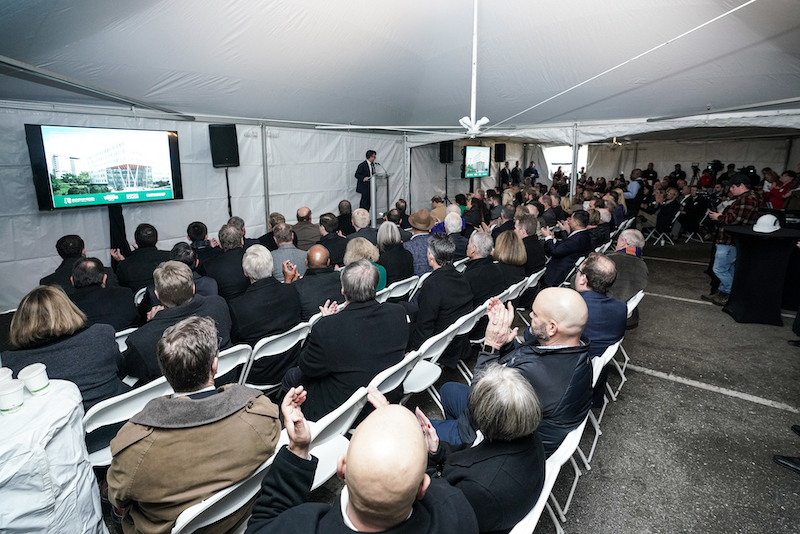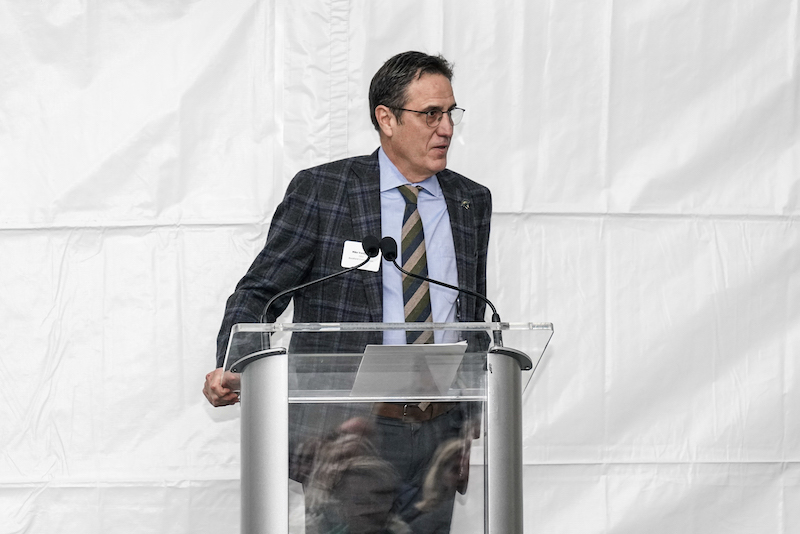Earlier this month, a real-estate development joint venture broke ground in downtown Grand Rapids, Mich., on the $85 million, 205,000-sf Doug Meijer Medical Innovation Building that is expected to drive innovation in life sciences through research, testing, and the commercialization of new therapies.
The project, which is scheduled for completion in in late 2021, is the result of a public-private partnership called Health Innovation Partners that includes Michigan State University (MSU), locally based GC Rockford Construction, and two Chicago-based firms Walsh Construction and Murphy Development Group. SmithGroup is the project’s lead architect.
Health Innovation Partners is leasing the land for the six-story Medical Innovation Building from MSU along the university’s so-called Medical Mile, next door to MSU’s 162,000-sf Research Center, which opened in 2017 and whose researchers concentrate on finding cures for cancer, Alzheimer’s and Parkinson’s diseases. The new building will include a 600-car parking structure. A third building is in the planning stage.

Over 250 guests, team members, and local officials turned out for the Nov. 18 groundbreaking of the Doug Meijer Medical Innovation Building in Grand Rapids, Mich.
MSU President Samuel L. Stanley, Jr., MD, stated during the groundbreaking ceremony that this latest project is one more step in Grand Rapids’ emergence as a national player in the health research and innovation space. Confirmed tenants for the Medical Innovation Building are the MSU College of Human Medicine, Spectrum Health, and BAMF Health, a biotech company focused on delivering AI-enabled medicine through molecular imaging and Theranostics.
Future tenants are likely to focus on cancer research, mental health, neurodevelopmental and neurodegenerative disorders, bioinformatics and artificial intelligence, digital and consumer-driven health technologies, and medical device development.
The new building is named after Doug Meijer, co-chairman of the supermarket chain Meijer, whose Meijer Foundation donated $19.5 million to the MSU Board of Trustees for the Medical Innovation Building’s construction.

Samuel L. Stanley, Jr., MD, President of Michigan State University (above), and Mike VanGessel, founder and CEO of Rockford Construction, a national construction and property management provider (below).

Related Stories
| May 5, 2011
Hospitals launch quiet campaigns to drown out noise of modern medicine
Worldwide, sound levels inside hospitals average 72 decibels during the day and 60 decibels at night, which far exceeds the standard of 40 decibels or less, set by the World Health Organization. The culprit: modern medicine. In response, hospitals throughout Illinois and the U.S. are launching "quiet campaigns" that include eliminating intercom paging, replacing metal trash cans, installing sound-absorbing flooring and paneling, and dimming lights at night to remind staff to keep their voices down.
| Apr 14, 2011
USGBC debuts LEED for Healthcare
The U.S. Green Building Council (USGBC) introduces its latest green building rating system, LEED for Healthcare. The rating system guides the design and construction of both new buildings and major renovations of existing buildings, and can be applied to inpatient, outpatient and licensed long-term care facilities, medical offices, assisted living facilities and medical education and research centers.
| Apr 13, 2011
Virginia hospital’s prescription for green construction: LEED Gold
Rockingham Memorial Hospital in Harrisonburg, Va., is the commonwealth’s first inpatient healthcare facility to earn LEED Gold. The 630,000-sf facility was designed by Earl Swensson Associates, with commissioning consultant SSRCx, both of Nashville.
| Apr 12, 2011
Mental hospital in Boston redeveloped as healthcare complex
An abandoned state mental health facility in Boston’s prestigious Longwood Medical Area is being transformed into the Mass Mental Health Center, a four-building mixed-use complex that includes a mental health day hospital, a clinical and office building, a medical research facility for Brigham and Women’s Hospital, and a residential facility.
| Mar 17, 2011
Perkins Eastman launches The Green House prototype design package
Design and architecture firm Perkins Eastman is pleased to join The Green House project and NCB Capital Impact in announcing the launch of The Green House Prototype Design Package. The Prototype will help providers develop small home senior living communities with greater efficiency and cost savings—all to the standards of care developed by The Green House project.
| Mar 14, 2011
Renowned sustainable architect Charles D. Knight to lead Cannon Design’s Phoenix office
Cannon Design is pleased to announce that Charles D. Knight, AIA, CID, LEED AP, has joined the firm as principal. Knight will serve as the leader of the Phoenix office with a focus on advancing the firm’s healthcare practice. Knight brings over 25 years of experience and is an internationally recognized architect who has won numerous awards for his unique contributions to the sustainable and humanistic design of healthcare facilities.
| Mar 11, 2011
Renovation energizes retirement community in Massachusetts
The 12-year-old Edgewood Retirement Community in Andover, Mass., underwent a major 40,000-sf expansion and renovation that added 60 patient care beds in the long-term care unit, a new 17,000-sf, 40-bed cognitive impairment unit, and an 80-seat informal dining bistro.
| Mar 11, 2011
Research facility added to Texas Medical Center
Situated on the Texas Medical Center’s North Campus in Houston, the new Methodist Hospital Research Institute is a 12-story, 440,000-sf facility dedicated to translational research. Designed by New York City-based Kohn Pedersen Fox, with healthcare, science, and technology firm WHR Architects, Houston, the building has open, flexible labs, offices, and amenities for use by 90 principal investigators and 800 post-doc trainees and staff.
| Mar 11, 2011
Mixed-income retirement community in Maryland based on holistic care
The Green House Residences at Stadium Place in Waverly, Md., is a five-story, 40,600-sf, mixed-income retirement community based on a holistic continuum of care concept developed by Dr. Bill Thomas. Each of the four residential floors houses a self-contained home for 12 residents that includes 12 bedrooms/baths organized around a common living/social area called the “hearth,” which includes a kitchen, living room with fireplace, and dining area.















